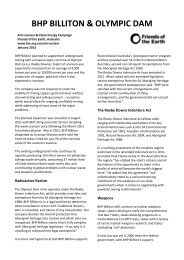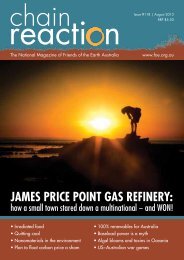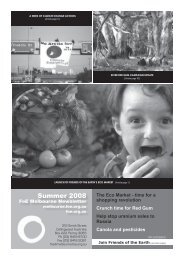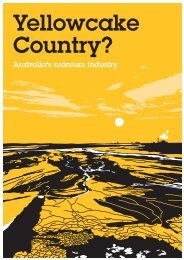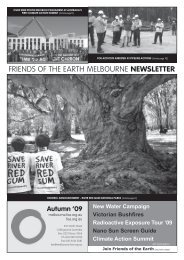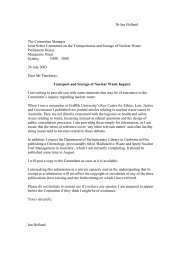Thirty Years of Creative Resistance - Friends of the Earth Australia
Thirty Years of Creative Resistance - Friends of the Earth Australia
Thirty Years of Creative Resistance - Friends of the Earth Australia
Create successful ePaper yourself
Turn your PDF publications into a flip-book with our unique Google optimized e-Paper software.
From 1985 until 1992, undercover <strong>of</strong>ficers<br />
with <strong>the</strong> Victorian Police Intelligence Unit<br />
(at that point called <strong>the</strong> OIU – Operations<br />
Intelligence Unit) carried out covert<br />
operations which involved monitoring<br />
and infiltrating key community groups in<br />
Melbourne.<br />
In hindsight, it all reads like a slightly<br />
strange Keystone Cops-type operation,<br />
with a specially adapted Holden panel<br />
van with darkened windows that would<br />
be parked near demonstrations and<br />
outside <strong>the</strong> <strong>of</strong>fices <strong>of</strong> non-government<br />
organisations. Many files on individuals,<br />
subsequently leaked to The Age<br />
newspaper in 1997, were appallingly<br />
sloppy, with names, affiliations and actions<br />
incorrectly recorded. Often people who<br />
attended a single meeting <strong>of</strong> a group were<br />
identified as “group leaders” because <strong>the</strong>y<br />
spoke at that meeting. Sometimes <strong>the</strong>re<br />
were separate files for <strong>the</strong> same person<br />
simply because no-one bo<strong>the</strong>red to cross<br />
reference shortened names with full<br />
names. But, <strong>of</strong> course, <strong>the</strong>re was a more<br />
sinister undercurrent to this work.<br />
According to The Age, <strong>the</strong> OIU went “far<br />
beyond its <strong>of</strong>ficial role <strong>of</strong> openly liaising<br />
with community groups”. It monitored<br />
groups as diverse as <strong>the</strong> Wilderness<br />
Society, 3CR community radio, <strong>the</strong><br />
Rainforest Action Group, <strong>the</strong> Victorian<br />
Council for Civil Liberties and FoE.<br />
It carried out electronic bugging and<br />
searches without warrants, as well as<br />
placing undercover police <strong>of</strong>ficers who,<br />
“using fake identities, ... penetrated<br />
conservation groups by posing as<br />
volunteers worried about <strong>the</strong> environment”<br />
(The Age, 1997).<br />
FoE was one <strong>of</strong> those groups that<br />
received a lot <strong>of</strong> attention: <strong>the</strong> Age noted<br />
that <strong>the</strong> <strong>of</strong>ficers “were so successful at<br />
infiltration... that <strong>the</strong>y helped staff <strong>the</strong>ir<br />
<strong>of</strong>fices, maintained files and updated<br />
membership lists. One undercover <strong>of</strong>ficer<br />
even spent two days <strong>of</strong> police time helping<br />
...................................................................................................................................................................................................<br />
Police Infiltration <strong>of</strong> FoE<br />
build shelves at <strong>the</strong> Collingwood <strong>of</strong>fices <strong>of</strong><br />
FoE. The group was so grateful it paid for<br />
a new blade for <strong>the</strong> electric saw <strong>the</strong> <strong>of</strong>ficer<br />
borrowed from a colleague in <strong>the</strong> covert<br />
OIU”.<br />
Information gained by <strong>the</strong> OIU was shared<br />
with <strong>the</strong> national intelligence agency, ASIO<br />
and also <strong>Australia</strong>n Army intelligence. The<br />
OIU later became <strong>the</strong> Protective Security<br />
Intelligence Group – PSIG – who were<br />
meant to destroy <strong>the</strong> hundreds <strong>of</strong> files on<br />
individuals. However, <strong>the</strong>y were simply<br />
(and illegally) moved out <strong>of</strong> a police <strong>of</strong>fice<br />
and into a house in order to avoid <strong>the</strong>m<br />
being destroyed.<br />
This was not <strong>the</strong> first or last time FoE<br />
came under attention from security<br />
services. As early as <strong>the</strong> 1970s, <strong>the</strong><br />
Victorian Special Branch was asked to<br />
“keep an eye on FoE” by steel and mining<br />
company BHP. An Inspector Norton<br />
reported on FoE activities to <strong>the</strong> company.<br />
And various companies, have placed<br />
people in <strong>the</strong> organisation. For instance,<br />
after a high pr<strong>of</strong>ile campaign on beverage<br />
packaging, a company employee was told<br />
by <strong>the</strong> PR and advertising manager <strong>of</strong><br />
Coca Cola in Adelaide to “attend F.O.E.<br />
planning committee meetings at <strong>the</strong><br />
(Adelaide) university; to go dressed in<br />
dirty jeans, T-shirt and sandals, and not to<br />
shave” (The <strong>Australia</strong>n, 6/11/1973).<br />
What is perhaps saddest about all this<br />
is <strong>the</strong> fact that, as an open, grassroots<br />
organisation, FoE has nothing to hide.<br />
FoE 30 <strong>Years</strong> 66



